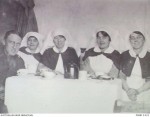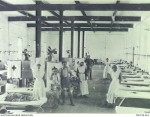JOHNSON, Bessie Shircliffe
Bessie Shircliffe Johnson was born on 2 July 1886, in the Fitzroy area of Melbourne to Webb Johnson (1863-1890) and his wife Kate (nee Ryan, no dates). Formally registered as Elizabeth at her birth, she was the sibling of Kate/Catherine Mary (born 1883) and Ryan (born 1889).
Bessie’s father Webb Sheircliffe (spelling varies) was of Irish extraction. Webb had been born at Riddells Creek in Victoria to Benjamin Burton Johnson and his wife Elizabeth (nee Sheircliffe). Benjamin (the son of a Church of Ireland clergyman) and his wife (a ‘gentlewoman’ at her marriage) had come to Victoria from County Cork in 1853, part of the population explosion of the gold rushes. They brought their three young children, and three more including Webb were born in the colony. Benjamin became a station master with the Victorian Railways, the largest employer in the colony, and later lived in retirement in Gore St, Fitzroy.
To date nothing has been uncovered about the family of Bessie’s mother Kate Ryan, also known as Catherine Benedicta Ryan (marriage certificate) and Bernadette Ryan (Bessie’s death certificate). She was presumably Roman Catholic, the religion recorded on Bessie’s enlistment papers.
Like his father, Webb Johnson also worked for the Victorian Railways. In about 1886, he and his young family moved to Quarry Hill (near Bendigo) because of Webb’s poor health, where he was the ‘chief operator of the Sandhurst Railway Station’ (Bendigo Advertiser, 2.6.1890). Sadly he succumbed to an ‘affection of the lungs’ (presumably tuberculosis) and died there aged 27 on 1 June 1890. His grieving widow Kate was left with three children, the youngest born the previous year.
The next two decades in the lives of Kate and her children are a blank. They may have lived with or near Webb’s comfortably off sister Kate Halford (nee Catherine Thornhill Johnson) in nearby Castlemaine.
In 1903, Bessie’s sister Kate married a cousin but his habitual drunkenness, violence and criminal activities forced her to support herself and her child with factory work before she escaped to Seymour where her uncle was station master. She was subsequently granted a divorce (Truth, 13.4.1918). In 1909 and 1910, Kate wrote to the local paper in Wagga, NSW, asking her brother Ryan Webb Johnson to contact her at the Seymour Railway Refreshment Rooms (The Worker, 25.11.1909, 29.12.1910).
Meantime Bessie, single, had become a nurse and trained at the Children’s Hospital in Carlton. Her decisions about nursing and then the particular training followed those of her cousin Bertha Halford. Bertha had trained at the Children’s in the late 1890s and then married a ‘witty young medico’ Dr Charles Perry (Table Talk, 12.7.1900; Argus, 3.7.1900). Bessie may have spent considerable time with Bertha as a child in Castlemaine. She later named Bertha as her next of kin on her enlistment form – a practical choice given her siblings’ circumstances and suggesting their mother Kate had died. She gave Bertha’s address as her permanent address.
When she applied to join the Australian Army Nursing Service in 1915, Bessie listed her professional experience as three years training at the Children’s Hospital, staff nurse at St Ives Private Hospital in East Melbourne and Mount Wise Hospital in Malvern, and two years private nursing.
Two factors may well have been influential in her decision to enlist. First, St Ives was owned and operated by Elizabeth Glover, a pioneering and highly influential figure in both civilian and military nursing (see Shirley Swain’s article, http://www.womenaustralia.info/leaders/biogs/WLE0525b.htm). Secondly, a desire to distance herself from her siblings and their difficulties may also have been at play. She neither nominated any immediate family as her next of kin nor made an allotment from her pay to support them.
War Service
Bessie Johnson served as an army nurse in three countries – England, Egypt and Greece. Her periods of duty there were punctuated with return voyages to Australia on hospital and troop transports.
Bessie joined the Australian Army Nursing Service in July 1915 – the first and only member of her immediate family to enlist – and sailed soon after on the ‘Orontes’. Her first period of duty was in London, at the Convalescent Depot (1 Australian Auxiliary Hospital) at Harefield, set up at the extensive home and grounds of ex-patriate Australian Charles Billyard-Leake for wounded Australian soldiers. It was expanding quickly in the two months (August – October) she was there.
In October 1915, Bessie was sent from Harefield to the County of London War Hospital at Epsom. There her patients came from all around the Empire. Five months later, she reported for duty at 1 Australian Auxiliary Hospital in preparation for nursing duties on the ‘Ascanius’ which was bringing sick and wounded troops back to Australia.
After spending three and a half months in Australia, perhaps nursing in army hospitals, Bessie left Australia for the second time in August 1916, as part of 14 Australian General Hospital which had just been raised in Melbourne. No 14AGH replaced 3AGH in Abbassia near Cairo, as many hospital units in Egypt relocated to the main fighting arena on the Western Front. Its nursing staff comprised Matron Rose Creal and 29 sisters and staff nurses (14 AGH, War Diary, AWM).
The hospital functioned in part as a clearing hospital, the number of patients rising with military activity and falling as patients returned to their units or were boarded back to Australia. The nurses’ accommodation was comfortable and few succumbed to illness despite the very trying heat. There was opportunity during Bessie’s time there for leave to Luxor, and most of the nurses visited the pyramids and other historic sites.
In March 1917 Bessie again returned to Australia, this time her nursing duties being aboard the ‘Willochra’. Again she spent winter in Australia before embarking for the third time overseas and for the second time to Egypt and Abbassia, this time with the rank of Sister. She spent eight months at the 31st General Hospital (a British hospital), from October 1917 to June 1918.
Bessie Johnson’s fifth and final hospital on active service was the 60th General Hospital in Salonika, Greece, where she reported for duty on 22 June 1918. The 60th was one of four British hospitals there that had been served by Australian matrons and nurses since 1917.
Johnson’s period there was less than a month. A considerable number of nurses became ill with malaria and/or dysentery and had to be evacuated, but debilitating varicose veins requiring surgery rendered Johnson medically unfit for general service from July 1918. The Medical Board who deemed her unfit for three months after any surgery recorded that the condition was ‘not caused by military service but aggravated by field service conditions’ (Service Record). She was invalided back to Australia via Suez and reached Melbourne on 4 October 1918.
After the war
Janet Scarfe
Adjunct Research Associate, Monash
29 January 2017
Can you help?
Can you correct or provide more information about this person?
Or are you able to help with this history project?
- Family stories and records including photos, documents and memorabilia?
- Stories or information in books, newspapers and on-line?
- Memorial plaques in churches and public places?
- War memorial, church, national and state archives?
If so, please Contact the East Melbourne Historical Society.



